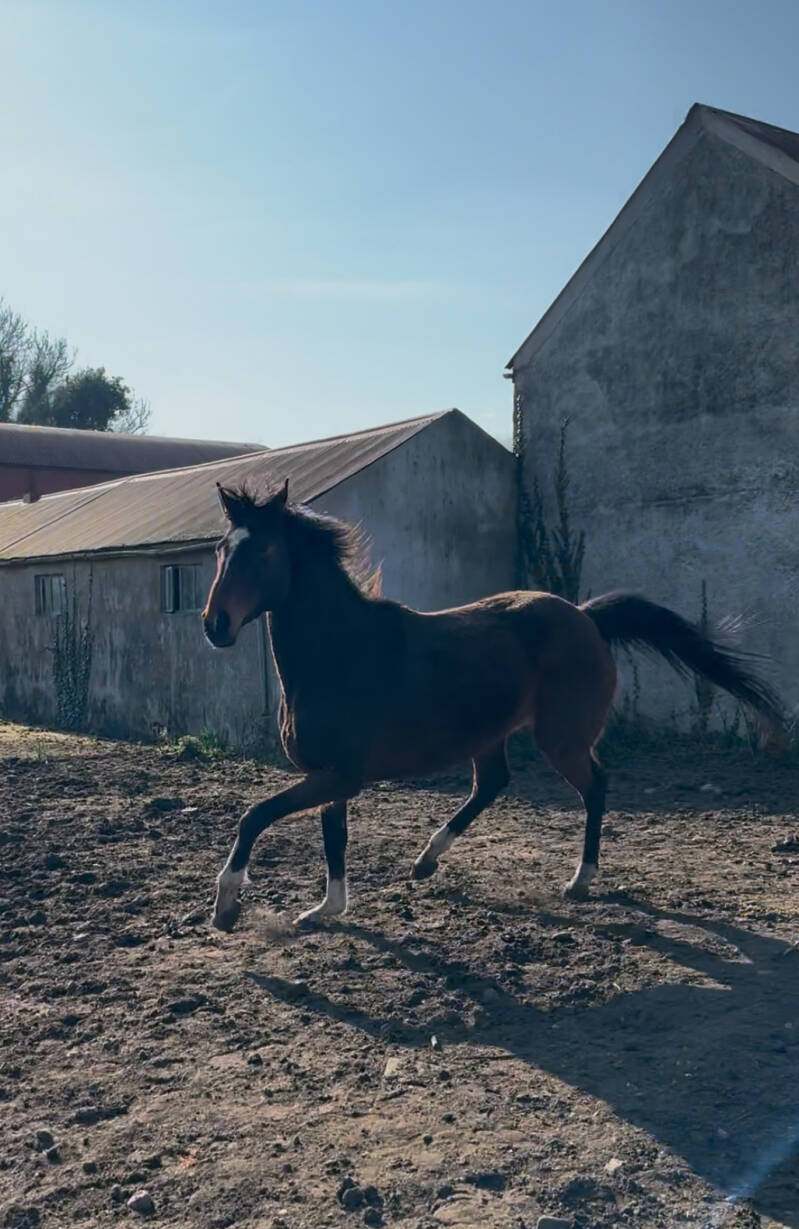Herd management the Shenanigan way

Living the Shenanigan life.
Our herd is made up of two of the most contrasting equine types, the Thoroughbred and the Shetland pony, often with vastly different dietary needs. Yet, there is one approach that can be surprisingly beneficial to both: housing them on a dry paddock with a consistent supply of good quality meadow hay.
Our herd has been established for 5 years now and our management model, as outlined below, has resulted in a very happy, active and healthy family herd. They live out together, with the choice of an array of paddock, barns and hardstanding to hang out. Meadow hay is always available, and is supplemented over the course of the day with seasonal plants, herbs, branches, fruits, and anything else we can think of to offer them to keep life interesting. Himalayan salt blocks are dotted around the site; an essential part of the whole digestive process.
Here is some of the scientific evidence for you to digest:
1. Nutritional Consistency and Control.
Grass growth is inherently inconsistent. Seasonal changes, rainfall, soil quality, and pasture management all affect the sugar, protein, and fibre content in pasture. For sensitive horses, this variability can lead to digestive upsets or metabolic issues.
Feeding good quality meadow hay on a dry paddock provides complete control over your horse’s forage intake. You know exactly what they’re eating and can adjust their diet accordingly.
2. Reduced Risk of Laminitis and Colic.
For Shetland ponies especially, pasture can be dangerous. Rich spring or autumn grass often contains high levels of fructans and sugars, which can trigger laminitis—a painful and potentially life-threatening condition.
On a dry paddock, sugar intake is managed. Meadow hay is typically lower in sugars than young, lush pasture, reducing the laminitis risk considerably.
A hay-based diet and the ability to constantly move about offers a steadier intake of fermentable fibre, improving gut function and stability.
3. Weight Management.
Keeping a Shetland pony at a healthy weight is a constant challenge, especially when grass is abundant. On a dry paddock, calorie intake can be better regulated. Soaking hay, if needed, can further reduce sugar content for easy keepers.
For Thoroughbreds, the worry is often the opposite—maintaining condition. A constant supply of high-fibre, palatable hay helps meet their energy requirements while supporting a healthy hindgut.
4. Encouragement of Natural Foraging Behaviour.
When hay is available ad lib in slow feeders or spread around the paddock, horses are encouraged to move and “graze” throughout the day.
This simulates natural foraging behavior and supports both mental and physical well-being.
For both breeds, this enrichment helps prevent boredom and supports healthy digestion. Ponies benefit from constant low-calorie nibbling, and Thoroughbreds benefit from the digestive stability of near-continuous intake.
5. Harmonious Herd Management
Housing Shetland ponies and Thoroughbreds together on pasture can be tricky due to differing nutritional needs. Dry paddock living levels the playing field.
It’s easier to feed the Thoroughbred supplemental high-calorie feed and balancer without risking overfeeding the Shetland.
Conclusion
While lush green fields might seem like the ideal image of horse keeping, the reality is that dry paddocks with consistent hay feeding offer a host of benefits—especially for breeds as diverse as Thoroughbreds and Shetlands.
Controlled nutrition, reduced health risks, and better behavioral outcomes all make this a smart, sustainable, and horse-friendly approach.
Whether you’re managing a spirited ex-racehorse or a savvy little native pony, your best pasture might just be… no pasture at all.
That’s why we do it how we do it.
Jo Wheatley
Shenanigan Stud Therapy Herd


New kids on the block
Welcome to Merry and Pippin. This sweet pair of Irish goats found themselves in need of a new permanent home, they have settled in well with the horses, ponies, dogs, and cats. They are incredibly cheeky and will regularly stroll into the cottage to check out what's on the TV, or snaffle goodies from the kitchen.
Merry has a tendency to get rather carried away when we have visitors to the herd, so he doesn't tend to get involved in therapy sessions conducted inside the yard. Hopefully he and his lady, Pippin, will take the lead from the rest of the Shenanigans and keep his impressive pair of horns to himself.

